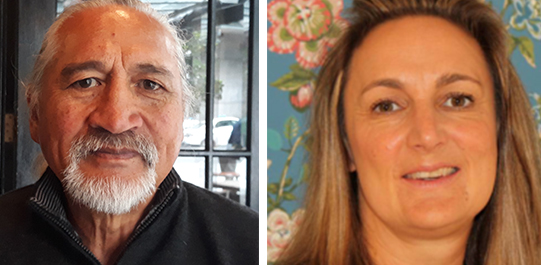Blog: Working restoratively to co-create safe health care – part two
 Jo Wailling, research associate with the Diana Unwin Chair in Restorative Justice at Victoria University of Wellington and Wi Keelan mental health and addiction (MHA) quality improvement programme kaumātua explore how restorative approaches can be used to proactively enhance safe health care.
Jo Wailling, research associate with the Diana Unwin Chair in Restorative Justice at Victoria University of Wellington and Wi Keelan mental health and addiction (MHA) quality improvement programme kaumātua explore how restorative approaches can be used to proactively enhance safe health care.
Jo presented on restorative practice at the Health Quality & Safety Commission’s workshop held in Wellington on 26 June for MHA leaders for the Te ako mai i ngā pāmamaetanga me te wheako tāngata whaiora me te whānau | Learning from adverse events and consumer, family and whānau experience project. Her previous blog discussed how restorative approaches can meet people’s needs after an adverse event.[1] This second blog of two continues the conversation, focusing on how restorative approaches might support consumer partnership. The authors posit that kaupapa Māori concepts and models provide a way forward.
So, what does meaningful consumer, family and whānau participation look like? There is no magic bullet, since the issue is enormously complex. However, there are some things we can learn from the restorative kete. To begin with, restorative approaches appreciate the untapped power of ordinary people, including the force for wellness generated by one’s own cultural beliefs and traditions. This power is best harnessed by uncovering multiple perspectives on an issue and appreciating each one on its own terms.
Restorative approaches also value relationships and see safe health care as a relational rather than individual responsibility. In a restorative approach ‘engaging’ with consumers is replaced by a framework which includes whānau, community partnerships and democratic decision-making. Solutions are co-created in a collaborative way, from individual consumer and whānau care plans, right up to system design.
The 2013 global health summit recognised that ‘the solutions to the health challenges of today and tomorrow won’t come from doing business as usual; they will come from building effective partnerships and harnessing the untapped global power of ordinary people.’[2] Restorative practices provide a practical means for achieving these goals.
Once we accept that every perspective deserves to be heard and that genuine partnerships are crucial, we begin to see that safe health care is not just the product of regulation, systems, models and pathways. It also involves people and relationships. It requires us to address the four pillars of wellbeing and health – taha tinana (physical), taha wairua (spiritual), taha whānau (family) and taha hinengaro (mental).[3]
Safe health care also requires us to question our own unconscious biases, assumptions and beliefs about consumers and their whānau and our role as health professionals in our relationships with them. We can begin to understand the truth of the Māori notion of Te Wheke that wellness is a shared experience and responsibility that embraces persons and whānau and rests on the concepts of balance and wholeness.
Does this sound like an idealistic dream? We would argue that such a goal is not only consistent with the protocols and processes health care organisations value, it is also consistent with the Te Tiriti o Waitangi principles of partnership, participation and protection that are foundational to New Zealand and should be embedded in all our actions.
Restorative circles are one way of enacting Te Tiriti principles. For centuries indigenous people have known the value of circular speaking, building better community, strengthening interconnectedness and conferring equal value on all. Wānanga hui (educational seminars) similarly allow different perspectives to be expressed in a safe and respectful way. They are mana-enhancing for all involved, with collective wellbeing at their core.
Before European contact, Māori had a well-developed system called utu that protected individuals, their social stability and group integrity. Likewise, restorative approaches continue to feature in contemporary kaupapa Māori mental health and addiction services with the use of karakia, waiata and other rituals aimed at harmonising the balance between people and their physical and spiritual environment. Wānanga and hui have a wide range of applications in health care, from clinical and cultural decision-making, to conflict resolution, to consumer and whānau education and participation.
We believe that working restoratively and sharing power through such practices will be more meaningful for Māori communities than contemporary engagement strategies and will benefit all consumers and promote safety in health care.
If we learn to work restoratively when all is well, we will be better placed to respond to harm in a restorative way when something goes wrong, as inevitably it will.
He waka eke noa: We are all in this together. We rise together or we fall together. So, let’s do this well!
Authors: Jo Wailling and Wi Keelan
- An adverse event is an event with negative reactions or results that are unintended, unexpected or unplanned (often referred to as ‘incidents’ or ‘reportable events’). In practice this usually refers to an event that results in harm to a consumer. Restorative approaches encourage us to consider all those affected by an adverse event, including families, whānau and health care professionals. See: Adverse Events Reports.
- Edgman-Levitan S, Brady C, Howitt P. 2013. Partnering with patients, families and communities for health: A global imperative. Report of the Patient and Family Engagement Working Group 2013. Doha, Qatar: World Innovation Summit for Health. p 1. URL: https://www.imperial.ac.uk/media/imperial-college/institute-of-global-health-innovation/public/27425_WISH_Patient-Engagement_web.pdf.
- Durie M. 1994. Whaiora: Māori health development. Oxford, UK: Oxford University Press.
